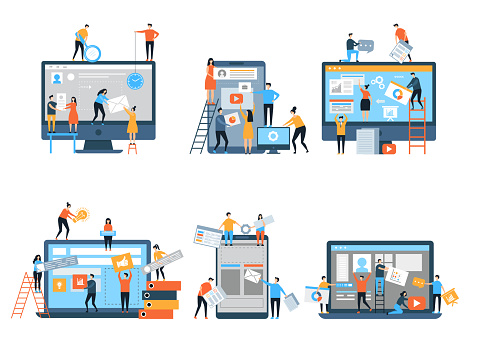
What is User Experience (UX) Design?
UX Design is exactly what it sounds like—design that focuses on the experience, needs, pain points, accessibility and pleasure that interacting with a digital feature brings the user. Instead of approaching design from a purely aesthetic point of view, UX design thinks about the functionality and value that something brings to an actual person.
When customer experience is improved, business thrives. Consider ESPN.com, who incorporated suggestions from users into their website design and saw revenues jump by 35%. Conversely, customers cut no slack for poor online experiences—70% of businesses will fail as a result of poor usability. UX design principles reduce the chance that your online customers will get frustrated with slow page speeds, confusing navigation, content with no value or confusing directions.
While UX principles can be considered in almost every area of marketing, it has the biggest impact on the digital customer experience. Three areas in particular—branding, content and website design—especially benefit from incorporating UX design into their strategy and execution.
When guiding your team to create a comprehensive digital marketing strategy, consider how these UX design principles can elevate the customer experience and drive revenue:
Branding
At its core, your company’s brand is meant to cultivate an emotional connection between your mission and your audience. Logic, data, benefits and reasoning all play their parts in your brand, but, ultimately, if your potential customers don’t feel connected to your organization or compelled by your messaging, they won’t invest in your products or services.
Brand consistency is extremely important to build a seamless user experience. Your brand should reflect the uniqueness of your company but still adhere to best practices for your industry. For example, you may want to check out what kind of imagery and colors are typically used by high-performing competitors in your industry. It wouldn’t make sense, for instance, if you cover your homepage in pictures of natural imagery if your organization is in industrial or manufacturing spaces. Using your brand visuals to provide a coherent, seamless experience that aligns with customer expectations reduces cognitive dissonance and promotes buying behavior.
Key takeaways:
- Incorporate key value messaging to communicate clearly with audience
- Use colors or imagery that guides people to certain actions/feelings
- Consider UX beyond marketing touchpoints to seemingly mundane tasks such as onboarding documentation and invoicing
Content
According to TechJury, as much as 4 million blog posts are published every day. With so much content across the internet, is it even worth spending the time and resources to create it? If your content adheres to good UX principles and provides value to your customers, it absolutely is worth it.
If you want your content to drive revenue, carefully consider what your potential customers need at each stage of their customer journey. What pain points are they facing? Where can your organization add the most value at this point in time?
Content format matters a great deal when getting the biggest bang for your buck. If content has lots of information, structure it to be scannable to breaking up text with headlines, subtitles, bulleted lists, callout quotes, etc. Linking to other relevant content is a great way to reduce bounce rate and encourage customers to check out multiple offerings.
It’s also important to think about how your audience wants to consume content. If you’re trying to reach decision makers, think about your own day: would having audio content be helpful? Downloadable content you can print? Highly visual content you can use to illuminate key points? Then, incorporate these different channels into how you build content: create podcasts with articles and blogs, provide download links to case studies or turn an industry report into an infographic.
Key takeaways:
- Build content with pain points and value as most important focal points
- Format content to be scannable and link to other relevant content
- Distribute content in ways that meet your audience where they are: Downloadable? Streamable? Closed caption? Visual?
Website
Your website is the hub of all your digital efforts and should be optimized to provide the best user experience. Since your website is 100% yours, unlike social media platforms or syndicated content channels, you have the most control over how your brand and content are experience by customers.
The aesthetics of your website are important, but you should consider functionality first. UX principles advocate for simplicity and an intuitive experience, which are most heavily influenced by site navigation. Cluttered, confusing navigation tabs and menus will easily frustrate customers and drive them from your website. Keep things streamlined and cap navigation tabs to 4-6 important ones, including a link to company information and contact forms, as well as compelling products and services description pages.
Page load speed is a make-or-break website feature and is impacted by the kinds of site elements you include. Embedding large video files, lots of big, high-resolution images or plug-ins can drastically reduce page load speed. 53% of web visitors will abandon a page if it takes longer than three seconds to load, so you literally have no time to waste.
Search engines are taking this behavior into account. In 2018, Google changed its algorithm to explicitly favor websites with mobile-responsive layouts and navigation. Now more than ever, it is imperative to ensure that your website avoids common website mistakes and provides a seamless mobile experience for all users. For a good starting point to create a mobile-friendly site, check out these tips from Hootsuite.
- Keep user navigation and behavior top of mind when designing site layout
- Favor loading speed and mobile responsiveness over fancy layouts or image-heavy designs
- Treat your website as a hub for all other aspects of digital marketing
Ultimately, UX design principles are proven to create a seamless user experience for your customers who reach out to your organization via digital channels. As more and more business moves online, and customers spend more time at the beginning of the buyer’s journey doing their own research, strong UX is vital to driving revenue and long-term success.

There are no comments